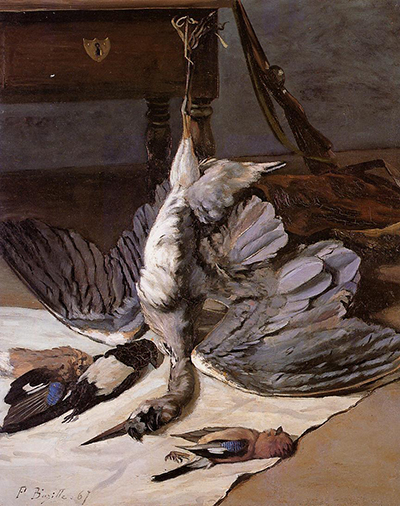Conspicuously different from Bazille's other work, The Heron, upon close inspection, contains many of the same traits and techniques commonly associated with the artist. Painting in his typical impressionist style yet adding his original flare of sharper, more salient brush strokes.
The colours - vivid - due to being painted with oil paint on canvas. Painted throughout the year of 1867, The Heron depicts a dead heron tied up by its feet with a rifle present in the background– suggesting it to be a hunting trophy. The heron is surrounded by two smaller sparrows lying on a white cloth. Despite Bazilles tendency to use darker palettes than many of his contemporary impressionist artists, The Heron is notably darker – perhaps lending to the clear theme of the painting being death. Another anomaly evident in the painting is that it is a still life painting and not painted in plein air, a rare technique for Bazille to implement.
We have evidence that this may not have been completely due to his own volition, as shown in a letter written to his mother imploring, “Do not condemn me to still lives forever!”, informing us that Bazille did not have the money to hire a model unless his mother helped him financially. We can thus imagine The Heron to have been a practice piece for Bazille in order to hone in his use of volumes and depiction of textures. The centrepiece and theme of the The Heron also has an explanation owing to Bazille’s love of hunting, evidenced by his hunting trips with his father in his native Montpelier.
We can surmise that Bazille found inspiration for The Heron in two of the artists that influenced him the most: Oudry and Chardin – both known for frequently depicting their hunting trophies in their paintings. The lyricism and elegance emanating from The Heron and various Bazille paintings could also be attributed to the influence of the two artists. Perhaps one of the most outstanding facts about The Heron is that a part of its creation has been captured in another painting. Aptly called, Portrait of Frederic Bazille painting The Heron painted by Monet. The Heron is now exhibited in the Musée Fabre in Montpelier, France.




